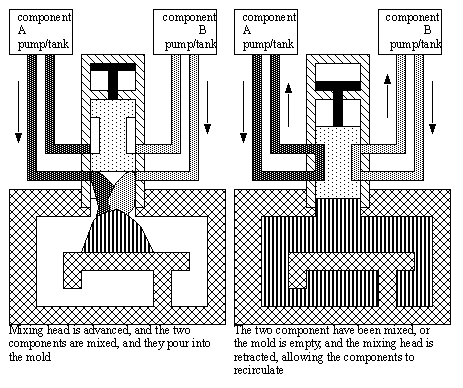
• Basic Principle - A mold is brought together, and a multipart thermosetting polymer is mixed and injected. After the part sets, the mold is opened, and the part is removed. Post curing may be used.


- Very little energy is required, most energy is provided by the chemical reaction.
- Parts up to 100 lb produced.
- Surfaces don’t have flow lines found in traditional injection moulding.
- RIM materials tend to be low weight, corrosion resistant, and variable properties can be obtained by additives and ratio adjustment.
- RIM machines use lower pressures, and are therefore less expensive.
- Typical parts are; bus bumpers, large electronics cases, shoes, etc.
- Fillers can be used to increase strength.
- The basic process involves mixing the raw components.

• Metering and mixing are critical
- special metering pumps are required for the components to maintain material properties.

- mixing must thoroughly mix the components at high speed, and inject them without becoming clogged when the mixture sets.

• While the previous mix head is for a runnerless system, it is also common to have an extra component that is between the mix head and the part (the runner).

• An aftermix may also be used to increase mixing. A typical design will split the stream and cause it to impinge at 180°, then continue on to the mold.
• A comparison of the materials shows the advantages over a similar injection molded material.

